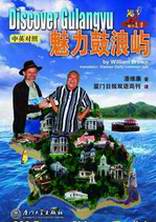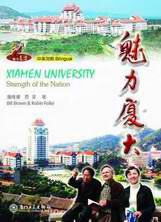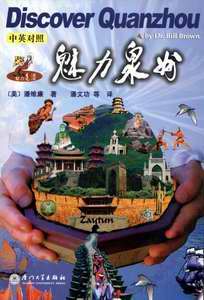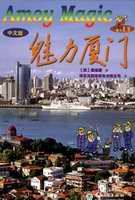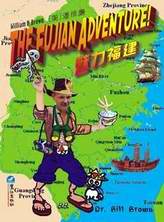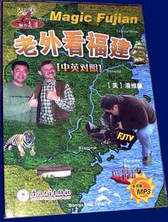![]() Click
to
Access
Click
to
Access
AMOY MAGIC SITE from
OUTSIDE China
![]() Click
to Access Amoy
Magic Site from
Click
to Access Amoy
Magic Site from
INSIDE
China ![]()
TRAVEL LINKS
![]() Xiamen
Xiamen
![]() Gulangyu
Gulangyu
![]() Jimei
Jimei
![]() Tong'an
Tong'an
![]() Jinmen
Jinmen
![]() Zhangzhou
Zhangzhou
![]() Quanzhou
Quanzhou
![]() Wuyi
Wuyi
![]() #1Fujian
Sites!
#1Fujian
Sites!
![]() Fujian
Foto Album
Fujian
Foto Album
![]() Books
on Fujian
Books
on Fujian
![]() Readers'Letters
Readers'Letters
![]() Ningde
Ningde
![]() Zhouning
Zhouning
![]() Longyan
Longyan
![]() Sanming
Sanming
![]() Putian
Putian
![]() Bridges
Bridges
![]() Travel
Info,
Travel
Info,
![]() Hakka
Roundhouses
Hakka
Roundhouses
![]() Travel
Agents
Travel
Agents
MISC. LINKS
![]() Amoy
People!
Amoy
People! ![]()
![]() Darwin
Driving
Darwin
Driving ![]()
![]() Amoy
Tigers
Amoy
Tigers
![]() Chinese
Inventions
Chinese
Inventions
![]() Tibet
in 80 Days
Tibet
in 80 Days![]()
![]() Amoy
Vampires!
Amoy
Vampires!
![]() Dethroned!
Dethroned!
![]()
![]() Misc.Writings
Misc.Writings
![]() Latest
News
Latest
News
![]() Lord
of Opium
Lord
of Opium
![]() Back
to Main Page
Back
to Main Page
Copyright 2001-7 by Sue Brown & Dr.
Bill ![]() Order
Books
Order
Books
Note:
Please click thumbnails
for larger photos!!
THE AMOY MISSION: Woman
in China
(Scanned and edited April 1st, 2008, by Bill
Brown, Xiamen University)
From Sangster, Mrs.
Margaret E., Ed., ¡°A Manual of the Missions of the Reformed (Dutch) Church
in America,¡± Board of Publication of the Reformed Church in America,
New York, 1877, pp.170-209
I
hope it is useful to you--and saves you a lot of time and $70!
![]() The
Amoy Mission, By Rev. WM. RANKIN DURYEA, D.D. 1877
The
Amoy Mission, By Rev. WM. RANKIN DURYEA, D.D. 1877
Part
1 Part 2
Part 3
WOMAN in China has been persistently degraded and oppressed. .As a child,
she is, and has always been, regarded as an unwelcome incumbrance. During
her early girlhood she has been immured as a prisoner. In her married
life, she has been a victim and a slave. It is only in her old age that
she has been regarded with honor and esteem. Could women in Christian
lands understand the absolute vacuity of existence, which life means to
even the most favored of their sisters in the flowery land, they would
not shirk the responsibility of sending them something better. That labor
among these women is abundantly repaid in success, is evidenced by the
testimony of our missionaries. They have been face to face with the souls
who sit in the house, of bondage. They have seen those but lately redeemed
from heathenism, willing to endure persecution, rather than abandon their
faith. They have witnessed the awakening of intellect, the quickening
of affections, and the growth of gentle graces, the fruits of the spirit,
so that before their eyes, the desert has blossomed as the rose.
THE WORK
IN AMOY.
Let us look at the work begun at Amoy, one
of the ports of China, in which, some of us have been permitted to labor.
The more direct work there, was commenced about ten years ago, by the
ladies of the Mission [Mrs. Talmage and Mrs.
Kip] meeting with the Chinese women from week to week; forming them
into classes for Bible instruction, praying with them, teaching them to
read, and encouraging them in the Christian life; and sometimes, perhaps,
being able to suggest to them in what way they might govern their children-in
which essential, they are quite as deficient as in the knowledge of books.
This work, though carried on amid many discouragements, has proved successful.
Many having learned to read the New Testament, and some colloquial books,
are much more attentive to the preaching of the Word, and better able
to understand and retain the truth. What they have thus gained, has not
been for each one alone.
The doctrine is often made known through them to others, to one of their
own family, or it may be to a friend or neighbor; in this way, some, we
trust, have been led to a knowledge of the true God.
This much has been accomplished, in the city churches. But what shall
we say of the women, at the country stations? Living, as many of them
do, a long distance from the chapel, they find it very difficult, with
their small bound feet, to walk to and from the service; besides, one
or more young children must always accompany the mothers, so that they
can seldom give their undivided attention to the preaching, even should
they desire to do so.
Then, again, although the preacher may strive to present the truth very
clearly and simply, probably they will not for any length of time, remember
what they hear. I have heard the preacher, in the early part of the service,
ask these women questions on Scripture truths; and when asked again, during
the same service, not one in ten could answer a single question, though
the answers had been many times repeated to them. They have never been
taught to think on any subject. Does it seem strange, then, that on hearing
any new doctrine, for the first time during their lives, they fail to
remember just from having it told them? Ah! if they could read, how different
it would be. Then, instead of hearing the Gospel only on the Sabbath,
they could daily search the Scriptures for themselves. Not until they
are able to do this, can we look for progress on the part of these neglected
and ignorant women.
A work on their behalf was begun two years ago, by the young ladies of
the Mission [Miss Helen M. Van Doren, Miss Kittie M. Talmage
and Miss Mary E. Talmage], who went out to
spend a few days, or a week, at a time, at the different out-stations,
hoping to teach many of these women to read. Of course, they met discouragements¡ªthese
were expected; still, the beginning of a good work was then made. It was
the more hopeful, as many of the children entered heartily into the plan
and became diligent pupils.
The great hope of the Church, is in the education and conversion of the
children. Although the Chinese think their daughters are not worth educating,
we are of a quite different opinion.
GIRLS SCHOOL
IN AMOY.
We are fully aware how much depends on their being educated, and taught
the Christian religion. For this purpose a school for girls, was opened
in Amoy, seven years ago. Here, have been
educated many of the wives of our helpers and teachers. The Bible has
been made the great text book of the school. In addition to this, however,
a number of other studies have been successfully introduced. They have
been taught geography, arithmetic, reading, writing and composition, and
have made good progress in each branch. Besides this, instruction has
been given in sewing and in domestic work. It has been our earnest desire,
that all the girls who come under our care, shall be thoroughly fitted
for all household duties, and shall obtain the knowledge they will so
greatly need in homes of their own. Very few have left this school, without
having professed their faith in Christ. Thus we have great reason for
gratitude to our Heavenly Father, and for encouragement in our work.
Here, in Amoy, we feel that a work is begun
and going forward, which will be of untold benefit, for years to come,
in the churches, and indeed, in all that region; a work well worthy of
faithful effort. Shall not the workers in this field have the kind counsel
and earnest prayers of all who remain at home? The work is great, but
let us have faith that it will be accomplished; when many shall thirst
for the hearing of the words of the Lord, and when this great kingdom,
now under the dominion of sin, shall be given to Christ, for His inheritance.
Can we hesitate to go forward, when we have the arm of God to strengthen
us? Is there anything too hard for the Lord? Lot us cease not, then, to
pray that the labors of these sent to teach may be blessed, and that those
who are taught, may themselves be made meet for the Master's use.
AN EXAMINATION AT AMOY.
We appropriately follow Miss Van Doren's statement, by a detailed account
of one of the annual examinations, dated June 19, 1876:¡ª
"Another year of the girls' school was completed yesterday. The closing
exercises were very interesting. The pupils with some of the parents,
and a few visitors, assembled at half-past nine, in the recitation room
of the school. The pastor of the First Church took charge on the occasion.
The older girls, after an exercise in reading, repeated the Psalms, which
they had committed to memory during the year. They had finished and reviewed
the first thirty. These were selected from the many Bible lessons of the
year, as giving a fair idea of what they had done. Then followed the examination
in geography; the recitations from the text-books were well given, after
which, oceans, seas, rivers, towns, etc., were pointed out, from the outline
maps, with great accuracy. Many of the lessons were repeated, first by
one pupil alone, then by the class in concert.
"The examination in arithmetic was the last one in colloquial; the
answers given, the repetition of the table of weights and measures, and
the work of the older girls at the blackboard, were all most satisfactory.
As this study has been by far the most difficult to teach, it was a real
pleasure to hear the ready explanations, and the application of the rules
in each division of the study; and more than all, it clearly proves that
Chinese girls can be taught to think for themselves, if sufficient care
and training is given them.
"The pastor, Choa, then took charge of the remaining exanimations,
which included all the lessons prepared in the character during the year.
A class of young ladies have just finished Genesis; this being their first
attempt in reading the Old Testament Scriptures; as they are more difficult,
their attention before this, has been given entirely to the New Testament.
After this, came the recitation of other classes, and finally all, down
to the youngest children, had passed the ordeal of a public examination.
A PUPIL TEACHER.
"The oldest pupil has now so far advanced in the study of the character,
that she has been promoted; and will, herself, have charge of this department,
during the coming year. We are thus able to dismiss the teacher we had
previously employed, and are much pleased to see this young lady in a
position of so much usefulness. It is, indeed, a step forward.
CONVERSION OF SCHOLARS¡ªMARRIAGE OF SAME.
"We had, last year, thirty pupils; and have this year, had but twenty-two.
During the six years existence of the school, fifty-seven pupils have,
at different times, been in attendance. Sixteen of this number have been
received into the Church. These all have an opportunity of imparting the
knowledge they have gained, to the many ignorant around them. Eight of
the pupils have been married since the school began, and six of these
were church members. All have married Christians. This is very important,
for each Christian household thus begun, is a light shining in a dark
place.
"Some parents seem happy, and are grateful in sending their daughters;
but many, still cling to the old idea, that girls are not worth educating.
Only slowly, can the notions of ages of superstition be swept aside. But
every educated woman will be a fact, preaching more loudly than many sermons,
for the elevation of her sex. We try to carry forward instruction in domestic
matters, side by side with tuition in books. The girls take turns in cooking,
and in the performance of all household duties. This arrangement enables
us to do without servants, and what is far more important, gives the pupils
the knowledge they will need in their own homes.
INQUIRY MEETING.
"An inquiry meeting is held every week, in the Church, near
the school. The girls attend regularly, and we have reason to feel that
it has been the means of great good.
BOARDERS AND DAY PUPILS.
¡°It is not considered proper, for a Chinese girl to walk about in public,
after she has attained the age of twelve. All our larger girls, who come
from the four churches in Amoy, as well as
from the adjoining country, board with us. The little ones are allowed
to go back and forth through the streets. It should not be forgotten that
this is
THE ONLY SCHOOL
for girls in a large
region, inhabited by not less than ten millions of souls.
THE MATRON.
"The matron is the widow of pastor Lo, whose name is here given.
She superintends the household affairs, and assists in teaching the younger
children.
THE INSTRUCTION IN CHINESE.
¡°My teacher, Liong-to, spent for some time four afternoons in the week
instructing the girls in reading and writing the Chinese character.
BIBLE STUDY.
"Though they have desired to read Christian books, it has been thought
best to make the Bible the important study of the school. Besides the
study of the character, instruction is given in the Romanized colloquial.
In this they prepare Bible lessons also, and are taught geography, arithmetic,
reading and writing. The larger girls are reading 'Pilgrim's Progress,'
and enjoy it very much. They have committed to memory all the parables
of our Saviour, and when school closed, they were learning the miracles.
They also write an analysis of one sermon on Sunday. A class of eight
little girls are learning the 'Sermon on the Mount.' The pupils commit
to memory very readily, and it is a pleasure to hear them recite.
DIFFICULTY OF TEACHING CHINESE GIRLS TO THINK.
"We find it very difficult to teach Chinese girls to think. As this
is something quite new to them, great patience is required in teaching
arithmetic, especially to beginners. For thousands of years, the mind
of woman in China has been a blank page; her conversation has consisted
of the most frivolous gossip. It is not wonderful that intellectual discipline
is not easy, all at once.
INSTRUCTION
IN SEWING.
"The matron, on each Wednesday afternoon, instructs the girls in
cutting and making their dresses. Many Chinese women are quite incapable
of making their own clothes. We particularly desire that all who attend
school shall be thoroughly taught in this department. On Saturday, the
morning is spent in putting the house in order and recreation, and the
afternoon is devoted to sewing."
THE TESTIMONY
OF THE PERSECUTED.
Possibly there are many in this Christian land who never remember what
it costs a heathen to give up the religion of his childhood, and embrace
Christ. The amount of suffering, both physical and mental, which some
of our Chinese converts have been forced to endure, reminds us of passages
which we have read in the history of the church of God, in all periods
when its members have had to combat error and superstition, even to the
death. But we have nothing in our own experience with which to compare
it.
Dr. Talmage, in 1874, wrote an account of
the persecution of a woman, who had dared to become a believer. She was
seized and placed in a sort of stocks, a punishment described by the Chinese,
as "sleeping in two rooms." The body is placed in one apartment,
and the feet are passed through a hole near the bottom of the wall, into
the next room, where they are secured. Sometimes, to make the position
more uncomfortable, one foot only is put through the aperture, and this
was the case in the present instance. The efforts of native Christians,
through the judicial courts, effected her release from this torture, but
not until they had baffled severe difficulties.
Two years later, Mrs. Talmage, in a letter
from Amoy, related the story of another Christian
Chinese woman. A little girl of nine, she had been given away for marriage,
as is common among the Chinese, her mother knowing nothing of the Christian
religion. Later, the mother learned the truth; and yearned with maternal
affection to have her daughter forsake idolatry, and come with her to
the cross. Whenever she found an opportunity, she taught her and urged
her to accept salvation through the Saviour. She at first, manifested
strong opposition, but finally understood¡ªyielded, and was baptized,
when in her nineteenth year.
The family of her husband were bitterly resentful, at this change in her
convictions; and her own friends, therefore endeavored to redeem her,
before the marriage was consummated, by the payment of a sum of money,
but this was refused. Her husband and his relatives treated her with great
severity. The former whipped her every day. Her bridal attire was taken
from her, and she was not allowed a room she could call her own, and was
obliged to sleep wherever she could find a place. This persecution, continued
in the determination to make her renounce Christ, she endured until she
was twenty-three years old, when her brother took her away by stealth.
For some years, she remained with her mother, attending church regularly,
and learning more fully the doctrines of the Gospel. Then, she yielded
to the persuasions of her husband, and trusting to his promises that she
should enjoy her faith unmolested, returned to his home. The promises
were soon broken; her life was far from comfortable; she was not permitted
to pray or read, and necessary articles of clothing were denied her. Her
son, in his fifteenth year, was threatened with severe chastisement, if
he followed in his mother's way. The mother is now in her forty-third
year.
Not long since, she attended one of the woman's prayer-meetings. She spoke
of her trials, and seemed almost in despair. "How is it?" she
said, "I have been praying and praying all these years, and yet there
is no answer." Mrs. Talmage encouraged
her still to pray, and to trust, telling her that in God's time, her prayers
would be heard. Surely those who read these pages, will add their petitions,
that this poor, loyal heart, on the far away shore of Amoy,
may be comforted at last; and that the grace of the Holy Spirit may reach
the husband, and all his family, and lift them from their darkness, and
bring them to a knowledge of the truth as it is in Christ.
A MISSIONARY
JOURNEY.
Pastor Yap, of the Second Church, in Amoy,
whose picture is here given, made, in June, 1876, a trip into the country
north of Tong-an, for the purpose of obtaining a place for a chapel, at
Poa-tan-chi, i. e., the market-village of Poa-tan. The place has been
secured, and the chapel opened. A preacher is now stationed there, with
one of the members of the Tong-an Church, as chapel-keeper, and assistant
teacher. Dr. Talmage afterward visited the
region, and thus described his journey:
POA-TAN.
"Poa-tan is in the district of Aukoe, the next district north of
Tong-an, about twenty-five miles from the city of Tong-an.
The road from Tong-an
city, for some miles, passes through a fertile valley, along the banks
of a beautiful stream. We left Amoy, in our
boat, on Friday, at 11 A. M., landed at Tesoa, and thence proceeded by
road over the hills to our chapel at Tong-an, where we spent the night.
"On Saturday morning, at seven, we left the chapel, and two hours
after, began to ascend the first mountain, arriving at the highest point
of the pass, about 2,000 feet above the level of the sea, a little after
noon. Here, we rested. Descending, we passed through another beautiful
valley, and climbed another mountain, arriving at its top at three in
the afternoon. From this point the descent is continual, first very steep,
then gradual, along the banks of a beautiful stream, until Poa-tan and
far beyond. We arrived at Poa-tan chapel at six, having spent eleven hours
on the journey, sitting in uncomfortable chairs, where the ground was
not too rough, and walking over the steeper ascents and descents.
SCENERY.
The scenery along the route was sometimes exquisite for beauty, and sometimes
impressive for wildness and grandeur. Perhaps the wildness and grandeur
predominated. But the loveliness of some of the gorges, both sides lined
with terraces far up the mountain steeps, sometimes to the very top of
the gorge, covered with growing crops, and with the exquisite green of
the rice, must be seen to be appreciated.
BOUGHNESS
OF THE ROAD.
"This road, like most of the roads in China, even on the level ground,
"is seldom wide enough, and never, for any great distance, smooth
enough for carts or wagons; and the steeper parts are always ascended
and descended by steps. It is a great thoroughfare. We met sedan-chairs,
with their passengers, many pack-mules, which are never seen at Amoy,
and many coolies with their heavy burdens. The goods coming down to the
sea-board market?awere chiefly iron, coarse porcelain, paper and charcoal.
THE MISSIONARY
STATION.
"Poa-taii is an important village, or rather cluster of villages,
on the banks of a small river, in the midst of an extensive, fertile and
populous valley. This makes it an eligible missionary station, where the
Gospel may be preached to great multitudes. At the chapel on Sunday, the
audiences, wholly composed of men, were large¡ªmorning, afternoon, and
evening. Between services, I went out, and in various places, addressed
women as well as men. The people everywhere seemed friendly. Their interest
was doubtless prompted by curiosity, for, as yet, we had no converts here.
Much of our preaching is like sowing seed by the wayside, or among thorns,
and yet we trust that some will be found to take root, spring up, and
bring forth fruit.
WHAT WE NEED.
"We need for this, your funds, to furnish the people with the Word
of God; and your prayers, that the Word may be accompanied by the Spirit's
power.
HOT SPRINGS¡ªTEA-FIELDS.
"Near our chapel, are hot springs, impregnated with sulphur. There
are also tea-fields in the neighborhood. All along the way are, here and
there, places where preaching-stations might profitably be established,
had we the men and means. Oh, how many such places there are in this land
of China! Who will come to take possession of them in the name of the
Lord?
"We journeyed
back, on Tuesday, met our 'Gospel-boat' just before dark, at Chioh-jine,
a few miles below Tonyan City, and having a strong south-east wind, two
hours and a half more, brought us home¡ªtired and thankful, and deeply
filled with the importance of great enlargement in our operations if we
would evangelize China."
A TOLL BRIDGE.
Accustomed, as we are, to swift modern modes of travel, and to the triumphs
of engineering skill, it is not easy for us to understand how rude and
primitive are some of the features of life in oriental countries. Perhaps
we have never thought very much about it, and we do not, therefore, consider,
as we ought, the privations to which our missionaries willingly submit,
nor do we remember that because of some of these difficulties, the work
of their hands progresses slowly. Dr. Talmage
tells about the first toll-bridge he crossed in China, in these words:
"A narrow causeway was raised for a few feet into the edge of the
river, then a single long plank was stretched from this to some natural
rocks farther in the stream; another plank reached from this to a few
large stones which had been placed there as a kind of abutment, and therefrom
still another extended to the opposite shore. This is not a very costly
or elegant structure, but the fare corresponds; being only two cash for
one person, so that the bridge may be crossed five times for one cent."
CHEAPNESS OF LABOR.
To illustrate the cheapness of labor in China, and the consequent toil
required of the masses, to obtain a mere living, it is stated that iron
is carried from the mines, mostly on mens' shoulders, though pack-mules
are used to some extent, many miles overland to Tong-an, and then is brought
by boat to Amoy; yet it is there sold for
about the price which pig-iron commands in New York.
A FIRST-CLASS
HOTEL.
Dr. Talmage, writing from Amoy,
in the fall of 1876, gave a graphic description of the resting-place,
at which he stopped on the journey to Poa-tan. He said:
"I can only guess at its dimensions. Its side walls being joint walls
of the adjoining houses, can have no windows, and probably would have
none, if they were not joint walls. Its floor is a few inches higher than
the street, close on which it stands. Its height on the eaves, on the
street, is seven or eight feet. The front room, some fifteen or twenty
feet, occupies the whole width of the house, is a little deeper than it
is wide; and serves for office, parlor, dining-room, kitchen and bedroom.
A dozen of us slept in it, the night we staid there. Having the ground
for its floor, no whitened walls, and no ceiling; it needs neither washing
nor scrubbing. Immediately behind this room are a few feet of open court,
or part of the house, without a roof; and two other bedrooms of the same
character as the front room, only, both together, much less than half
its size, and more dirty. For the accommodation of the entire party, the
whole charge was twenty-seven cents, enough to pay the rent of the establishment
for some weeks. This house was a fair sample of all the houses of the
village. We selected it to pass the night in, because it was reported
to be the best and cleanest inn on the route."
BEAUTY OF
CHINESE VILLAGES.
Many of these villages are enchanting in the distance. The lovely grassy
knolls, delightsome brooks, magnificent shade trees, and fruitful fields,
with mountains rising gloriously in the background, combine to make them
most attractive. But once look into the houses, and scan their immediate
surroundings, and the poetry vanishes. Usually it vanishes even before
that, for the sights and smells which greet you at the entrance of the
village, take it all away. You can often smell a village, some time before
you get to it. Yet the people who reside amid such filth, regard themselves
complacently, as the only civilized race on the globe; and think of Europeans
and Americans, as barbarians. I was gravely asked, by an old woman, at
the inn: "Do you, in your country, have the family arrangement? Do
men have their own wives? Do you acknowledge such relations as parents
and grand-parents?" I answered, "Yes." With pleased surprise
she turned to the bystanders, and said:"Why, they do!¡±
A WALK IN
A CHINESE CITY.
A Chinese city is not in the least like London or Paris, or New York or
Philadelphia. Some years ago, foreigners were rigidly excluded from all
the populous towns of the Flowery Land; but now many of the seaports are
open, and travellers walk through them without molestation.
Walls are built round the towns, and we enter by gates; but even outside
the gates are streets of closely-packed houses and shops.
NO HIGH HOUSES IN CHINA.
You find in China no high houses, no broad streets, no horses. You see
indeed some high roofs and tall towers, but these belong to pagodas or
temples, and the people are forbidden to raise their houses very high,
lest they should over shadow the idol temples. Few houses have more than
one story. They look like big toys, for they have often fancifully carved
roofs with curved corners. Some of the roofs are painted in bright colors,
bells are sometimes hung from the corners; and at times, the figure of
a dragon is seen, who the inhabitants think will protect them from evil
spirits and bad influences. You will find no glass in the windows, but
instead, very thin paper, or small panes made of thin oyster-shell.
HOW BURDENS ARE CARRIED.
"How are burdens carried, when there are no horses and few broad
streets?"
Well, you see a river runs by the town, and canals have been made in different
directions. The rivers are as busy and crowded as roads. Thousands of
people live on river-boats, and vessels of different sizes, row up and
down the water, laden with passengers and cargo. If you do not wish to
travel by the river, and prefer not to walk, you can get into a sedan
chair or palanquin. There will be no difficulty in finding some one to
carry you.
Hundreds of coolies do the work of horses in every town. They carry not
only passengers, but chests of tea, bales of silk, and all sorts of cargo,
making quite as much noise as cart and carriage wheels, while they rush
about with their burdens, crying, "Ah ho! Ah ho!:' from morning till
night. The cry seems to help them, as sailors say their call, "Pull
ahoy," does half their work. The coolie's work is very hard, and
he is worn out after a few years of labor.
HOW THE PEOPLE DRESS
The coolies, and most of the men you meet, are dressed in dark blue cotton,
the color universally worn by the poorer classes. Their dress, their hair,
their eyes, their faces, seem all precisely alike. In town or country,
you seldom see a Chinaman who has not coarse black hair, and small black
eyes. The richer and higher ranks of people, wear costly and bright colored
clothing of embroidered silk, satin and furs. The long tail of hair is
an indispensable ornament for the men; only the coolies, who find it in
the way, twist it into a knot at the back of their heads. Very few women,
and those only of the poorest, walk in the streets.
CARRYING FANS, AND FLYING KITES.
Everybody is provided with a fan. A Chinese soldier would stop fighting
to fan himself, and a laborer, taking a rest, uses his as gracefully as
the lady of leisure. It does duty also, in place of a hat; and is held
over the head, to protect it from the sun. Grown up people, and grave,
elderly gentlemen, too, are often seen amusing themselves with kites,
which flutter in the air like birds.
BRIGHT-COLORED SIGNS.
By the sides of the shops hang gaily colored boards, bearing mottoes,
advertisements and fanciful names. Sometimes a whole street is devoted
to one article; as combs or copper-kettles. Tinkers, barbers, cobblers,
smiths, carvers, portrait painters and tailors, are selling and making
their wares, and crying out their praises to every passer-by.
HOW CHINESE LADIES LIVE.
The married lady is expected to rise early, and see that tea is prepared
for her husband; and that hot water is awaiting his convenience, when
he desires to take his morning bath. She must also pay equal attention
to her mother-in-law; for China is the Paradise of old women,?aand while
her husband's mother lives, his wife is a very secondary personage indeed.
The ladies go about en dishabille in the early portion of the day, shouting
out vehement orders to their servants, and confusion reigns.
The elaborate toilet of the lady of rank, is the great business of the
day. In this, is there not something in common with too many votaries
of fashion in better instructed conditions? Aimless and frivolous, wherever
she be, who lives mainly to adorn her person and display her dress, she
is not greatly elevated above her Chinese sister. Each fashionable woman
in China has one or two maids, and a slave-girl to wait on them. The latter
makes it her first care to trim and light the pipe of her mistress.
ADJUNCTS OF THE TOILET
The dressing of the lady's hair occupies from one to two hours. A white
paste is next applied to her neck and face, a rose powder to eyelids and
cheeks, and a red dye to the finger nails, and she is then attired for
the day.
OCCUPATIONS OF CHINESE WOMEN.
Many ladies devote much time to gossiping, smoking and gambling; in which
latter vice, they follow the example set them by the men. They always
play for money, and when they have no visitors of their own rank to play
with, they do not hesitate to engage in games with the servants. Numbers
of ladies, however, are skilled in embroidery; and shoes, purses, handkerchiefs
and robes pass through their cunning fingers. Before marriage, they occupy
their time in preparations for the wedding¡ªa sad wedding, one would imagine,
when often the bridegroom is a stranger, whom they have never seen, and
for whom they cannot care. Here and there, a woman is found, who has learned
to read, and her accomplishment is in real demand. She can while away
the tedious hours, by reading tales and plays, to her less fortunate friends,
who are willing, often, to pay for the pleasure she bestows.
God speed the time when the blessed change, which the coming of His kingdom
ever brings, shall dawn, not only, but go on to the grandeur of noon,
in the land of Sinim.
Back to The Amoy Mission Project
Please
Help the "The Amoy Mission Project!"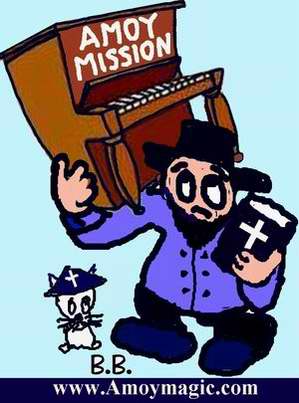 Please
share any relevant biographical material and photos for the website and
upcoming book, or consider helping with the costs of the site and research
materials. All text and photos will remain your property,
and photos will be imprinted to prevent unauthorized use.
Please
share any relevant biographical material and photos for the website and
upcoming book, or consider helping with the costs of the site and research
materials. All text and photos will remain your property,
and photos will be imprinted to prevent unauthorized use.
E-mail: amoybill@gmail.com
Snail Mail: Dr. William Brown
Box 1288 Xiamen University, Xiamen, Fujian PRC 361005
![]() Favorite
Fujian Sites
Favorite
Fujian Sites ![]() Fujian
Foto Album
Fujian
Foto Album ![]() Xiamen
Xiamen
![]() Gulangyu
Gulangyu
![]() Fujian
Guides
Fujian
Guides ![]() Quanzhou
Quanzhou
![]() Zhangzhou
Zhangzhou
![]() Longyan
Longyan
![]() Wuyi
Mtn
Wuyi
Mtn ![]() Ningde
Ningde
![]() Putian
Putian
![]() Sanming
Sanming
![]() Zhouning
Zhouning
![]() Taimu
Mtn.
Taimu
Mtn. ![]() Roundhouses
Roundhouses
![]() Bridges
Bridges
![]() Jiangxi
Jiangxi
![]() Guilin
Guilin
![]() Order
Books
Order
Books![]() Readers'
Letters New: Amoy
Vampires! Google
Search
Readers'
Letters New: Amoy
Vampires! Google
Search
Last Updated: October 2007
AMOY
MISSION LINKS
![]()
![]() A.M.
Main Menu
A.M.
Main Menu
![]() RCA
Miss'ry List
RCA
Miss'ry List
![]() AmoyMission-1877
AmoyMission-1877
![]() AmoyMission-1893
AmoyMission-1893
![]() Abeel,
David
Abeel,
David
![]() Beltman
Beltman
![]() Boot
Family
Boot
Family
![]() Broekema,
Ruth
Broekema,
Ruth
![]() Bruce,
Elizabeth
Bruce,
Elizabeth
![]() Burns,
Wm.
Burns,
Wm.
![]() Caldwells
Caldwells
![]() DePree
DePree
![]() Develder,
Wally
Develder,
Wally
![]() Wally's
Memoirs!
Wally's
Memoirs!
![]() Douglas,
Carstairs
Douglas,
Carstairs
![]() Doty,
Elihu
Doty,
Elihu
![]() Duryea,
Wm. Rankin
Duryea,
Wm. Rankin
![]() Esther,Joe
& Marion
Esther,Joe
& Marion
![]() Green,
Katherine
Green,
Katherine
![]() Gutzlaff,
Karl
Gutzlaff,
Karl
![]() Hills,Jack
& Joann
Hills,Jack
& Joann
. ![]() Hill's
Photos.80+
Hill's
Photos.80+
..![]() Keith
H.
Keith
H.![]() Homeschool
Homeschool
![]() Hofstras
Hofstras
![]() Holkeboer,
Tena
Holkeboer,
Tena
![]() Holleman,
M.D.
Holleman,
M.D.
![]() Hope
Hospital
Hope
Hospital
![]() Johnston
Bio
Johnston
Bio
![]() Joralmans
Joralmans
![]() Karsen,
W&R
Karsen,
W&R
![]() Koeppes,
Edwin&Eliz.
Koeppes,
Edwin&Eliz.
![]() Kip,
Leonard W.
Kip,
Leonard W.
![]() Meer
Wm. Vander
Meer
Wm. Vander
![]() Morrison,
Margaret
Morrison,
Margaret
![]() Muilenbergs
Muilenbergs
![]() Neinhuis,
Jean
Neinhuis,
Jean
![]() Oltman,
M.D.
Oltman,
M.D.
![]() Ostrum,
Alvin
Ostrum,
Alvin
![]() Otte,M.D.
Otte,M.D.![]() Last
Days
Last
Days
![]() Platz,
Jessie
Platz,
Jessie
![]() Pohlman,
W. J.
Pohlman,
W. J.
![]() Poppen,
H.& D.
Poppen,
H.& D.
![]() Rapalje,
Daniel
Rapalje,
Daniel
![]() Renskers
Renskers
![]() Talmage,
J.V.N.
Talmage,
J.V.N.
![]() Talman,
Dr.
Talman,
Dr.
![]() Veenschotens
Veenschotens
. ![]() Henry
V.
Henry
V.![]() Stella
V.
Stella
V.
. ![]() Girard
V.
Girard
V.
![]() Veldman,
J.
Veldman,
J.
![]() Voskuil,
H & M
Voskuil,
H & M
![]() Walvoord
Walvoord
![]() Warnshuis,
A.L.
Warnshuis,
A.L.
![]() Zwemer,
Nellie
Zwemer,
Nellie
![]() Fuh-chau
Cemetery
Fuh-chau
Cemetery
![]() City
of Springs
City
of Springs
(Quanzhou, 1902!!)
![]() XM
Churches
XM
Churches ![]()
![]() Church
History
Church
History ![]()
![]() Opium
Wars
Opium
Wars
![]() A.M.
Bibliography
A.M.
Bibliography
![]() YMCA
Volunteer!
YMCA
Volunteer!
![]() XICF
Fellowship
XICF
Fellowship![]()
![]() Temples
Temples![]()
![]() Mosques
Mosques
![]() Christ
in Chinese
Christ
in Chinese
Artists'
Eyes
DAILY LINKS
![]() FAQs
Questions?
FAQs
Questions?
![]() Real
Estate
Real
Estate
![]() Shopping
Shopping
![]() Maps
Maps
![]() Bookstores
Bookstores
![]() Trains
Trains
![]() Busses
Busses
![]() Car
Rental
Car
Rental
![]() Hotels
Hotels
![]() News
(CT)
News
(CT)
![]() Medical
& Dental
Medical
& Dental
![]() Expat
Groups
Expat
Groups
![]() Maids
Maids
![]() Phone
#s
Phone
#s
EDUCATION
![]() Xiamen
University
Xiamen
University
![]() XIS(Int'l
School)
XIS(Int'l
School)
![]() Study
Mandarin
Study
Mandarin
![]() CSP(China
Studies)
CSP(China
Studies)
![]() Library
Library
![]() Museums
Museums
![]() History
History
DINING ![]() Tea
Houses
Tea
Houses
![]() Restaurants
Restaurants
![]() Asian
Asian
![]() Veggie
Veggie
![]() Junk
Food
Junk
Food
![]() Chinese
Chinese
![]() Italian
Italian
![]() International
International![]()
![]() Visas
4 aliens
Visas
4 aliens
RECREATION
![]() Massage!
Massage!
![]() Beaches
Beaches
![]() Fly
Kites
Fly
Kites
![]() Sports
Sports
![]() Boardwalk
Boardwalk
![]() Parks
Parks
![]() Pets
Pets
![]() Birdwatching
Birdwatching
![]() Kung
Fu
Kung
Fu ![]() Hiking
Hiking
![]() Music
Events
Music
Events
![]() Cinema
Cinema
![]() Festival&Culture
Festival&Culture
![]() Humor&
Humor&![]() Fun
Fotos
Fun
Fotos![]()
BUSINESS
![]() Doing
Business
Doing
Business
![]() Jobs!(teach/work)
Jobs!(teach/work)
![]() Hire
Workers
Hire
Workers
![]() Foreign
Companies
Foreign
Companies
![]() CIFIT
(Trade Fair)
CIFIT
(Trade Fair)
![]() MTS(Translation)
MTS(Translation)
![]()
Back to Top
